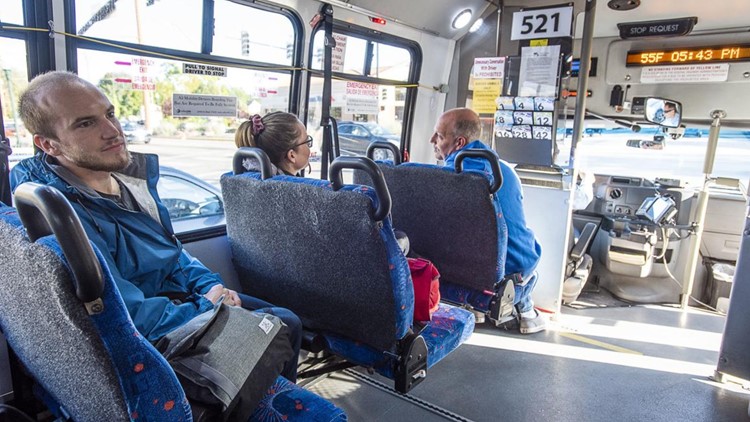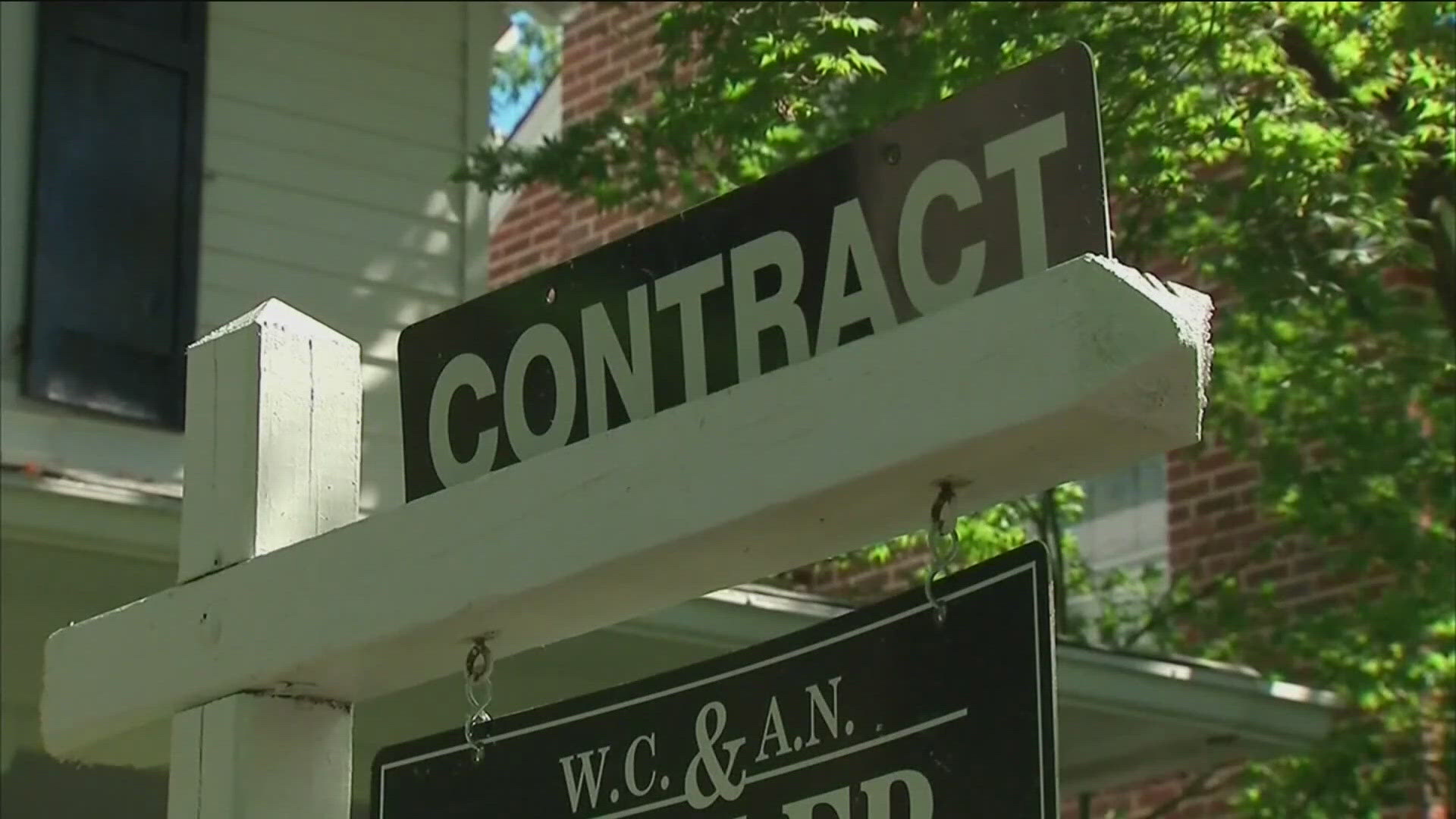BOISE, Idaho — Jesse Hart has a car of his own, and he still rides the bus down State Street to work in downtown Boise five days a week.
He boards at the intersection of State and Glenwood streets, the far terminus for one of Boise’s most popular routes, instead of braving the growing congestion on the busy commuter corridor. State Street’s five lanes carry over 20,000 cars into Boise every day; that number is increasing rapidly as Boise becomes denser and subdivisions materialize to keep up with the influx of Treasure Valley residents, according to a report from the Idaho Press.
Boise transportation officials say convincing more residents who could drive, like Hart, to take public transit or another method to get around the city, instead of just widening roads to accommodate the traffic, is the only way to make growth manageable.
“I think more people should do this,” Hart, 27, said last week, while cruising down Vista Avenue on a Valley Regional Transit bus, heading to the airport. “It’s not just about the freedom of having a car. We need to think outside the freedom of having a car and come up with a sustainable solution to the growth we’re experiencing.”
It’s no secret that the public transit system in Boise is lacking. Boise currently provides 87% of VRT’s $18.5 million budget, which all comes from the city’s general fund. Daren Fluke, Boise’s comprehensive planning director, acknowledged the less-than-stellar ridership on the existing bus system, and he said the only way to improve it is to continue to invest, and increase frequency and running times, so more people see it as a feasible alternative to driving.
“With transit it’s always that chicken and egg problem,” he said. “Nobody’s riding the bus, so why should we provide more service? But people will never ride the bus if you don’t have better service.”
To entice more people to ride, Boise recently poured over $1 million additional dollars into VRT and changed its funding formula so the city’s contribution to transit increases along with property tax revenue growth. This was largely focused on increasing frequency on some of the most popular routes, including Vista Avenue and State Street. Both have 15-minute service during peak commuting hours and 30-minute service on Saturdays. Vista also has 30-minute service during the middle of the day through the evening, and extended service until 9:15 p.m.


From August 2018 to August 2019, average weekday boardings in Ada County fell 5%, but where VRT upped service ridership increased. In that same time period, average weekday boardings on State Street increased from 648 to 740, a boost of 14%. Vista saw a similar jump from 333 to 408, an increase of 22.5%.
Stephen Hunt, principal planner for VRT, said he is pleased with the increases in ridership on those two routes, and he hopes to see that trend systemwide. He said several routes in the city have been affected by construction, and some routes have taken a downward turn as riders have changed to other bus lines with the reorganized system. Routes hit hard by construction include Emerald, Five Mile and Overland.
“Ridership has improved some, and we’re going to continue to chase riders. But to get them on the rest of the network, we need to continue to look for ways to improve,” Hunt said. “In particular, we need to acknowledge the impact of construction and other activities that are impacting our ridership.”
The crown jewel of Fluke’s dream for Boise’s transportation system is a Bus Rapid Transit system with 15-minute frequency on State Street. This system would include lanes along each side of State Street called Business Access Transit (BAT), only to be used by buses and drivers turning to access businesses.
The special buses would stop at raised train-station-like platforms with ticket booths to pick up passengers quickly and shuttling them past the traffic and into the downtown core.
This vision began to take shape in 2004 when the city did a study on alternative transportation options along State Street. The study found that in order to keep reasonable commute times on the busy corridor, the street would need to be widened to nine lanes, Fluke said. Instead of heading down that route, planners switched up their playbook and started planning for bus rapid transit. They took their cue from similar, popular systems in Bogota, Colombia; Cleveland, Ohio; and Eugene, Oregon.
COST OF RAPID TRANSIT
A bus rapid transit system would not be cheap. In 2011 dollars, it was estimated that a full bus rapid transit system extending from downtown Boise to Highway 16 in Star and up Highway 55 into Eagle would cost $475 million to build. There is no current price estimate for a system extending from Boise to the State and Glenwood intersection, and officials are working on details and planning for how the improvements could be funded.
Although some taxpayers might balk at the price tag, Fluke said many people fail to take into account subsidies for cars when they get frustrated about public costs for transit. In Ada County, the highway district uses registration fees, fuel taxes and property taxes to fund roads. Fluke pointed out that no one is upset that this subsidizes drivers who drive by themselves, but they protest higher taxes to boost transit service.
“Cars don’t pay for themselves either,” he said.
Buses aren’t always full, but neither are cars. On average, 20% to 30% of seats on a VRT bus are full, he said. Yet, “a regular vehicle has four to six seats in it, and it’s got one person — then you’ve got a 25% seat utilization rate,” he said. “We never think of the system that way.”
BOISE’S GOAL
Earlier this year, Boise City Council proposed a goal of reducing solo commuter car trips in the city by 10% by 2029. Currently, 80% of drivers in Boise drive to work alone, so the aim is to shift that number down to 70% in the next decade. This would still be a much higher rate than the comparably sized city of Madison, Wisconsin, which has roughly 63% of commuters driving alone to work.
Boise officials estimates that the city will see an additional 50,000 new residents in the next two decades, which would lead to an additional 200,000 new daily vehicle trips by 2040 if drivers’ habits do not change and new transit options don’t become more feasible. Left unchecked, the city estimates there could be approximately 190,200 vehicle trips on Interstate 84 west per day by 2040. There are roughly 140,000 today.
According to national research conducted by the Institute of Transportation Engineers, every household in America produces an average of 10 one-way car trips a day. This number is higher for households with multiple drivers and children, and significantly lower for single adults living by themselves. It also includes packages delivered to the house. If Boise were to meet the proposed goal, every household would only have to cut out one of these trips per day.
City transportation planners are still working on the plan to provide more transportation options for residents. Earlier this year, planners pitched more park-and-ride lots, a network of pathways along canals, more useful signage at bus stops, and technology to allow buses to travel through intersections first to stay on time. More details on these ideas are expected next month.
Hart, who already commuted on the State Street route prior to the improvements, said he’s noticed an uptick in riders since the bus started running more frequently. He said adding improvements like bus rapid transit would make the system even more popular with residents who currently drive to work. Other changes he hopes for are an express system with fewer stops, and more spots on the bus to store bicycles.
“Most people think it’s a good thing I ride the bus,” he said. “They see it as an altruistic thing to do.”
More from our partner Idaho Press: $3.4 million research award granted to St. Luke's for suicide study



